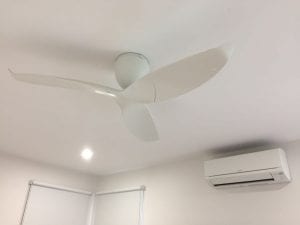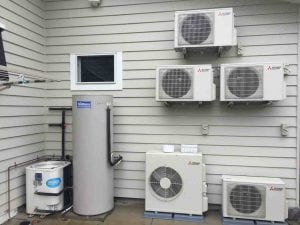The unveiling of the Coalition government’s new energy policy appears to lock in Australia’s extraordinary high energy costs for at least another decade. This will encourage yet more households and businesses to turn to solar, and to battery storage to minimise their costs. Some will look to leave the grid altogether to be rid of the high network costs.
This is a story of how one Brisbane family left the grid, the lessons learned, and what others should consider.
 Design Considerations:
Design Considerations:
In 2014, we decided to move out of an inner city suburb and started looking around for a suitable house on a few acres in a semi-rural area on the outskirts of Brisbane.
Unfortunately, all the housing stock seemed to be 20 years old and had next to zero environmental efficiency.
As we wanted to limit increasing operating costs in our retirement, we began planning to build a new house that had the type of energy efficiency we wanted, and was modern, comfortable and had resale market appeal.
We were always going to have solar, and you need a generator for emergency supply for drinking water pumps, but the house was located 180 metres from the front of block, so we started investigating going entirely off-grid as the cost of the batteries was about the same as the cost of an underground powerline to the road.
To make the whole thing feasible we designed the house to 8.5 star energy rating standard. This included siting the house with a north east aspect well away from overshadowing trees (also helped with BAL fire rating).
We chose fibre cement cladding, light coloured colourbond roof with 65 mm anticon blanket insulation, R4 insulation on the ceiling, R2.7 acoustic insulation in the external walls and R2 i n all internal walls.
n all internal walls.
It was important to upgrade all windows to 6 mm low-e glass. Choosing LED lights throughout, a 315 litre heat pump hot water system, combination gas and induction cooktop and efficient split system airconditioners was also essential.
As summer temperatures in our area can be very hot for long periods we chose airconditioners running on efficient R32 gas, which allows us to have 3 2.5kW units in the main bedrooms, and 7.1 kW and 3.5 kW units in the living and TV areas.
In all the main rooms we have super-efficient DC reversible fans for summer and winter operation to aid air circulation and comfort.
Solar and Batteries:
Our solar system was set up by ECoast Energy, an off-grid specialist from the Sunshine Coast. We have 40 panels set up on the house and garage roofs. 14 panels are on AC coupling maximising northerly and westerly aspect for day aircon and evening loads (7.28kW) and 16 panels on DC coupling utilizing northeast, north, northwest aspects for early battery charge and consistent daily sun path charging (4.16kW).
When we made the decision in late 2014 to use sealed unit lead acid batteries (24 x Bea 2V batteries providing 14.5 Amp hour rating storage) we knew, just like whenever you buy a new camera or computer, they would quickly be superseded by newer, better and cheaper options.
But just like the new camera decision, if you don’t just bite the bullet you end up procrastinating forever.
Knowing this, we opened a bank account and put $50 per month into our “sinking fund” so when we need to replace the batteries they will be bigger in capacity, smaller in footprint, more efficient and cheaper. More on this below!
Our system uses a Midnite DC solar controller which is dedicated to recharging the batteries, ABB (Selectronic Certified) managed AC controller providing direct power during the daytime and additional charging for the batteries and a Selectronic SP Pro inverter for getting the power back out and overall management of the system.

We found it very difficult to get accurate advice as to the combined impact of all the various combination of features you need to get right, so we probably over-engineered it all a bit, just to sure. Then we fine-tuned things over the 12 months we have been living here and we want to share some of this learned experience.
Off-grid Living Experience:
Living in Queensland, energy efficiency is more about keeping cool in summer than winter heating. In the winter just past, even though it was warmer than average, we still had many nights where the temperature dropped in the 2 to 5 degree range.
By closing up the house at dusk, we normally started with an inside temperature of 20 – 21 degrees. Most nights it only went down to 19, with a drop to 18 on the coldest mornings.
We only turned the bedroom aircon heating on 2 or 3 times and then only for 30 minutes. The rest of the time we used no heating at all.
In summer we open the windows at night and close them by 7 am. Inside stays 10 to 15 degrees cooler than outside with no cooling, but if it gets up to 24 we turn on the big airconditioners and turn them off at dusk.
Our batteries usually go down to 80 to 85% overnight with our background usage (3 fridges, appliances on standby etc). On sunny days they are full again by 10 or 11 am. Our heat pump hot water system comes at 11 and stays on till the water heats up to 61 degrees (normally only a couple of hours, but longer in winter). We have enough daytime power to do whatever we want, including pumping irrigation from the creek for the gardens.
To improve the efficiency and comfort of the system we have recently invested in a few external blinds on windows that get direct sunshine and have put in a low-power vented exhaust system in the roof cavity to expel hot air in summer.
The only other thing we would change is (next time?) we would build the house with 900 mm eaves instead of 600 mm to give better shading and weather protection.
Going off-grid requires proper planning and design, but also you have to modify your behaviour in a sensible way, so you put off using dryers and ovens and high use appliances at night and during cloudy weather.
Our main power controller (SP Pro inverter) has been programmed by our installer in consultation with us to protect the batteries by automatically switching on the generator if power is being used to quickly, or if the state of charge of the batteries falls below prescribed levels.
These “business rules” can be tailored to suit our needs and can be modified remotely as required. We hardly ever need the generator on, but when it is required it charges the batteries in an hour or two and doesn’t use much diesel fuel in the process.
We read a lot about renewable energy and many of the stories have come across about other people’s off-grid experience tend to focus on tales of extreme self sufficiency, carbon neutrality and home-made solutions.
Each to their own, but we wanted a modern lifestyle without the hassles of being dragged into the hassles of escalating power prices and anarchic energy policies from big, voracious power companies and inept government leadership and bureaucracies.
The fixation of much of the debate on return on investment and payback periods in our minds had to be balanced against the peace of mind of locking in our energy expenditure up-front. As part of the cost of a new build, the marginal cost of insulation, energy efficient appliances and windows is only an extra few percent.
Our only costs now are topping up the generator every now and then and some LPG for the stove and BBQ. We also have a 130,000 litre rainwater tank so we never run out of beautiful clean, free water. On average, over the past 12 months, we use about 26 kWh of power a day.
On hot sunny days, with the airconditioners going, we sometimes generate/use 35 kWh or more. As we are not connected to the grid, the system only generates whatever power we are using after the batteries have been recharged to 100%.
Replacement Options:
We always looked on our lead acid batteries as an entry point. Since then we have seen all sorts of technology coming on-stream.
Salt water, flow batteries and of course lithium batteries with the big name Tesla making headlines have all advanced the choices now available.
Recently, we have particularly noted the introduction of a turn-key solution in a cabinet the size of a fridge by Melbourne company Arvio. At the top they have an SP Pro inverter, a tiny communications computer, and switching gear (all made in Melbourne).
In the cabinet below, the really exciting bit of kit is a supercapacitor energy storage device –like a battery but using graphene instead lead/acid or lithium.


Unlike traditional chemical-based batteries, supercapacitors can be charged in seconds, are capable of millions of charge/discharge cycles, will not burn or explode and are more environmentally friendly in terms of being made from readily available carbon rather than rarer and more toxic metals like lithium or cobalt. Our guess is that when it comes time to replace our batteries, this will be the dominant technology.
Lessons Learned: Summing up our off-grid experience-
- If you can afford to do so, particularly if you are building a new house, go off-grid
- Make all the right design and material choices to keep cold and heat out
- Reduce energy requirements by lighting and appliance choices and sensible modification of your behaviour and activity timing
- Keep an eye on new technology and have a long term saving plan to buy into better equipment down the track when you can benefit from upgrading
- Talk to as many people as you can about renewable energy and your off-grid experience in the hope that eventually the general public can be better educated and this may someday filter down to State and Federal Government politicians so they can then catch up with the rest of us!
